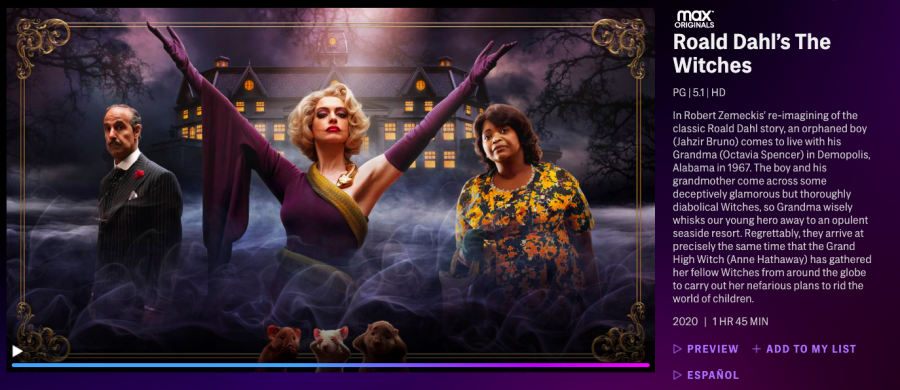HBO Max’s “The Witches” feels like a weird episode of the 2005 sitcom, “Everybody Hates Chris,” delivering over-saturation, lack of character development and conflicting creative directions that ultimately send this movie off the rails.
“The Witches” is a 2020 movie directed and written by Robert Zemeckis, based on the 1983 Roald Dahl book of the same name. The book was previously adapted into a film in 1990 starring Anjelica Huston.
The 2020 version of the movie stars Anne Hathaway as the grand high witch, Octavia Spencer as grandma and Jahzir Bruno as the hero boy, as listed by IMDB.
“The Witches” does not know what it wants to be. The way this movie is shot, edited, scored, acted and even written feels as if at every level there was a major clash of creative direction, causing for a bland movie experience.
The movie is set in 1968 Alabama, where an orphaned boy goes to live with his grandmother. However, after a run-in with a witch at a supermarket, Grandma moves the two to a seaside resort for the weekend. Little do they know, the Grand High Witch has gathered her coven there to carry out her evil plans.
The plot is the first major problem. Instead of presenting the movie with the snappy and witty charm Dahl is known for packing his books with, the plot feels like an ogre, with one big ugly center and long arms and legs that spear out in every direction.
Comedian Chris Rock narrates the movie as an older version of the presented protagonist. However, it’s never explained how or why he’s there, and he is ultimately more distracting than useful. The movie attempts to get you to care about the young boy, specifically that he lost his parents, but because starting a movie with the protagonist losing their parents is such an overused movie trope, it has no success in connecting the character to the audience.
There is a lack of a main character, as well as any successful attempt to make the watcher emotionally care about anyone in the film, made painfully obvious by the way the movie’s editing strays away from certain characters, plot lines or events.
Spencer’s character, Grandma, is the movie’s best attempt at creating a good all-around character. Her backstory is the most coherent, and her character is the best acted. Although, one of the biggest examples of creative direction clashing is presented here.
The editors and cinematographers of this movie decide that she is the main character, as evidenced by having the camera fixed on her for a straight 30 seconds in one scene. The writers, on the other hand, think differently. They write in dialogue, and scenes for hero boy present him as the main character instead.
The other main characters in this movie aren’t utilized in a productive and interesting way at all either. The other children, being Daisy, Mary and Reginald, are either used as the butts of jokes or as emotional tools the directors use once then throw away. Stanley Tucci plays the hotel manager, but he serves absolutely no purpose to the story.
Any of these characters could have been used to give a comedic or dark, emotional edge to the film, but are instead used as lackluster plot devices. Hathaway, playing the grand high witch, puts a weird spin on her character, taking out any comedic aspect while constantly switching between a French, German and British accent.
This lack of unified creative direction is evident in the story structurally and visually as well. Parts of this movie feel like a Disney live-action remake, specifically in the first act as well as the way the witches are depicted in the third act. The witches do weird synchronized movements, such as walking or sitting in an orderly fashion, but that only gets shown twice, failing to build any character development.
Starting in the second act, the movie turns into a psychedelic mid-century fantasy movie, reminiscent of Netflix’s 2020 television series “Ratched.” Guillermo del Toro, who helped pen the script for the movie, puts his own spin on the film’s digital graphics. The main scene in the second act features heavy horror-esque CGI, which del Toro is known for.
The children’s actions in the third act is where Zemeckis puts his spin on the film. The shot selection and use of CGI mirrors another one of Zemeckis films, 2004’s “Polar Express,” or the 2009 Disney family-comedy, “G-Force.” The soundtrack, unfortunately, doesn’t make the film any better. It switches from 60’s pop-rock to a Hans Zimmer type orchestral score, adding to the already disjointing feel of the entire movie.
The movie’s attempts at creating comedic, tense or emotional situations are always undercut by the scene directly following. Even the ending of the movie removes the audience from its cinematic world and dampers what could have been one of the film’s higher moments. A movie that is supposed to be filled with mischief and magic is instead monotonous and creates a lack-luster experience.



